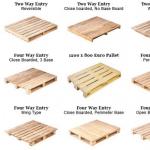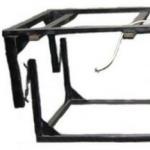Decorative dumping is called bulk materials of various fractions used for decorative soil mulching.
It can be stone chips, large and small gravel, pebbles, shells, sand, wood chips (including painted), bark, pine nut shells, as well as artificial decorative “pebbles” made of glass or plastic.
The use of various decorative dumps in the landscape design of the site can completely transform the appearance of your property. A number of decorative compositions - a Japanese "dry" landscape, a rock garden or rockery, a sandy garden, a landscape pond - are almost unthinkable without some kind of dumping. 
In addition, they can be used to create paths and patios, and for decorating flower beds, and for many other purposes. Mulching the soil under the plants protects it from excessive evaporation of moisture.
And using colored decorative chips in the garden, multi-colored glass, filling with crushed stone of various fractions and shades, you can achieve completely unusual effects.
organic dumps 
Among the organic decorative dumps, the most popular are pine bark, cedar husks and wood (including painted) chips.
The advantages of pine bark include, first of all, a long service life: it does not rot for a long time (especially large fractions), does not burn out. In addition, such decorative filling is an environmentally friendly material that naturally fits into landscape compositions.
Cedar husks and wood chips are dyed in different colors and thus provide a wide field for experimenting with color in the garden. Staining of decorative wood chips is made with eco-friendly paints. 
Of course, brightly colored wood chips should be used with caution in the garden: both the color of the mulch and the composition as a whole should be consistent with the environment. Excessively bright colors of colored decorative chips, for example, are out of place in landscape compositions.
But a variety of colors will allow you to create unusual colored soft paths or a colorful coating for a playground.
The disadvantages of the material include its relative lightness, due to which the filling can be carried by the wind.
An undoubted common plus of all organic dumping is their cheapness. These materials are inexpensive in themselves, and some of them (bark, wood chips) are by-products of woodworking industries. 
The main disadvantage is a relatively short service life (compared to inorganic dumping).
Using decorative fillings of organic origin in flower beds, tree trunks, etc. - wherever they are laid directly on the ground - it should be borne in mind that the lower layer of mulch that rots over time changes the composition of the soil on which it lies.
Most organic fills acidify the soil. For some plants, this property of dumping can also be an advantage - for example, for lovers of acidic soils such as rhododendrons.
When laying the dump directly on the ground, it is advisable to add a certain amount of material annually - this will, firstly, preserve the appearance (colored chips may fade over time, the color becomes dimmer), and secondly, it compensates for the rotting of the lower layer.
inorganic deposits 
Inorganic dumping includes crushed stone, gravel of various fractions, pebbles (river and sea), sands. Alternative types of dumping include materials of artificial origin - colored glass and plastic (multi-colored decorative "pebbles").
Gravel is a natural stone of small fractions of various shapes (both smooth and sharp-angled stones can come across). Gravel filling is used to decorate secondary garden paths, patios, and driveways.
Crushed stone is crushed stone chips, usually with uneven, sharp edges and corners. Crushed stone is made from stones of various breeds (it can be marble, shale, sandstone, granite, limestone), and, accordingly, can be of a wide variety of colors. 
A pebble is a small smooth natural stone with rounded outlines. Sea pebbles with multi-colored pebbles are especially beautiful.
Sand is decorative dumping of the smallest fractions. Usually, the smallest fractions of one rock (quartz, marble) or small crumbs of mollusk shells (sea sand) are used.
The advantages of inorganic (natural) deposits are primarily in the long service life. Gravel filling does not burn out, does not crumble, does not change its appearance. 
Stone dumps practically do not demand leaving. In addition, graveling prevents the soil from overheating and does not retain water.
One of the main disadvantages of such backfills is that it is quite difficult to remove accumulated debris from them (primarily tree litter), so it is better to place crushed stone paths and compositions with gravel backfilling away from trees.
Over time (over several seasons), inorganic dumps can become silted up, sand, soil particles and seeds can get into them. As a result, weeds appear on the covered surface (even on top of the geotextile).
However, they fall out quite easily. You can also use chemical herbicides (Roundup, Tornado, Hurricane, etc.).
Use of dumps in the garden 
The most widespread decorative dumping received in the design of paths and patios. However, they can also be used as a decorative mulch in flowerbeds, as a low-maintenance alternative to lawns, and for decorating tree trunks.
To create paths, all types of decorative fillings (including organic ones) can be used. To form such a path, a shallow pit is dug, geotextiles are laid (to prevent weeds from sprouting from the soil), after which the backfill is poured.
The optimal layer is about 7-10 centimeters. So that the path does not “spread”, you can strengthen its edges - for example, lay them out with a stone of a larger fraction. 
Using the same technology, large free spaces can also be decorated with backfill (as an alternative to a lawn or, for example, as an element of a Japanese dry garden). By combining dumping of different colors and fractions, you can achieve interesting effects.
To diversify the composition, you can add one or two expressive green plants to it. To do this, a crosswise incision is made in the geotextile, a plant is planted in the resulting hole.
In addition, dumping can also be used as elements of various decorative compositions - for example, to create "stone screes" on alpine hills, in rockeries, on the shore of a reservoir. 
Sometimes dumping can serve to emphasize and highlight certain specific plants. In this case, it is a good idea to choose a backfill that contrasts in color with the foliage of the plant.
Decorative mulching with organic materials can also be an excellent option when establishing a garden and planting perennials. As you know, the first or second years after planting are traditionally losing for most perennials.
If you plant them at a distance that is optimal for their further growth and development, bare ground will inevitably remain between the flowers, which most gardeners do not like so much. 
However, if you decorate these spaces, for example, with wood chips, then the “voids” will look like part of the design idea, and the garden as a whole will take on a complete look.
Currently, many summer residents prefer to equip flower beds with decorative gravel. The reasons for such popularity are quite weighty - it is inexpensive, beautiful and reliable. You can arrange such a flower bed in a few hours.
By itself, crushed stone is obtained by crushing rocks, such as granite or marble. Its fraction is usually small (at least 5 mm), you can choose crushed stone of any color you like. On sale you can find products of various shapes, popular options with sharp corners or a streamlined shape.
More recently, in quarries, crushed stone has been mined specifically for decorative purposes, and it is also painted there. The paint used is absolutely safe for both humans and the soil.. It is resistant to various weather conditions, its color does not change either during precipitation or during the scorching sun.
Ways to use crushed stone in decoration are as follows:
- decorative gravel is often used to decorate flower beds or ponds;
- crushed stone is great for filling paths and paths;
- often with the help of decorative gravel, beautiful patterns are created in the flower beds.
First of all, those areas in the garden that are the most problematic are decorated with decorative gravel, for example, where grass does not grow, where there is waterlogging or too much shade. It is not necessary to use only small pebbles - it can be diluted with a couple of large stones.
The bottom of a decorative reservoir will look beautiful if you decorate it with the same rubble, painted in blue or blue. Large boulders can be added here, a reservoir will look especially attractive if the boulder protrudes from the water. Crushed stone is used to fill the alpine hill. Here it is a mandatory element to fill the space around the planted plants. Thus, the maximum proximity to natural natural conditions is achieved.
If you plan to create a Japanese-style garden, then you can’t do without stone decorations. Stone is an integral part of Japanese design. Such a garden is also called the "garden of the void", it is a territory completely lined with stone. The earth is first sprinkled with small gravel, waves are created from the larger one, large stones and boulders are placed in a random order, symbolizing islands and mountains. Such a garden also needs care, a special rake will help here. It is with them that they create a water effect on the stones, and circles are mainly drawn around large boulders. In such a simple way, you can create the effect of a stone that was thrown into the water.
How to fill around plants?
Filling with decorative gravel is very simple, the procedure will be as follows:
- 1 First you need to prepare the soil, remove the top layer of soil (no more than 10 cm).
- 2 The next step is to lay the curbs that will delimit the territory. You can use borders made of absolutely any material.
- 3 Then it is necessary to pour sand into the prepared recess (no more than 5 cm). The sand itself is covered with a material that will simultaneously let water through and prevent sand and gravel from mixing. For example, you can use a plastic film with pre-drilled holes in it.
- 4 The final step will be the laying of decorative gravel. If you plan to decorate flower beds and create patterns, then you can pour no more than 2 cm of rubble. If you need to fill up the tracks, then 5 cm of rubble is enough for this. For work, it is better to take 2 types of crushed stone: you need to pour a small one on a large one so as to exclude unnecessary gaps between the stones.

How to paint gravel yourself?
You can also paint the rubble yourself, choosing exactly the color that is needed in a particular case. Acrylic and alkyd paints are suitable for creativity, you can take a coloring aerosol enamel in a can. Each pebble (previously washed) must be painted first on one side, then wait for the paint to dry, and then paint over the other side. As a rule, the paint dries quickly, so the whole process does not take much time. The main thing is not to try to apply a thick layer of paint at once - it is best to make a thin layer and see how it will look after drying.
If the result is not too bright, then it will be possible to paint over the pebbles again.
The above method is only suitable if only a small number of stones need to be painted. When it comes to a large volume, this method disappears immediately. To paint a large amount of pebbles, you need to put it in a container and pour the paint there. Crushed stone must be mixed properly so that each pebble is stained. Some use a concrete mixer for this purpose.
How to decorate a lawn with gravel?
If only crushed stone is available, but you need exactly streamlined pebbles to decorate a flower bed, then you can easily get out of this situation. To do this, you need any volumetric container, cement and paint. Creating a streamlined shape will be achieved during painting. The creative process is carried out in the following sequence:
- 1 To begin with, it is necessary to pour 1/3 of the existing crushed stone into the container, and paint must also be poured there. Everything must be thoroughly mixed.
- 2 After everything is mixed, water is added to the rubble (2 times more than paint).
- 3 Cement is poured out (the amount can be adjusted independently), and everything is mixed. At the end, the remaining rubble is poured in, after which everything is mixed again.
Those stones that are completely stained with cement must be taken out and laid on a grid so that they dry out. For this, you can use ordinary polyethylene. After the stones are completely dry, you can evaluate the result: the rubble has acquired a more streamlined and smooth shape and has been properly painted over.
You can decorate with such rubble any flower bed, garden path, shaded area near the entrance.
Despite the fact that the melon is a "purebred southerner", summer residents grow it not only in the south. And all because this culture is exceptionally tasty and very healthy. And varieties “for the market” do not always have high taste qualities, not like fruits from their own garden or greenhouse. True, the melon has its own "secrets", but they are not particularly difficult. Therefore, if you have not yet grown a melon on your hundred square meters, you must definitely try it, at least once!
Salad "Red Sea" with squid, crab sticks and red caviar is a light and healthy snack that is suitable for a pescatarian menu, it can also be prepared on fasting days when fish and seafood are allowed on the menu. The salad is simply extremely tasty and it is prepared easily. Buy frozen squids. I do not advise you to cook a dish with giant squid fillet, although it looks appetizing and tempting, it has a sharp ammonia flavor that is difficult to get rid of.
Columnar trees differ from ordinary fruit trees in their compact crown, small height, and lack of lateral branching. With a slight habitus, these miracle trees are distinguished by their ability to form large crops of large, tasty and beautiful fruits. On 1-2 acres, you can place up to 20-25 columnar trees - varieties of apple trees, pears, plums, peaches, cherries, apricots and other crops of different maturity. Our article will tell about the features of creating a columnar garden.
August can be a little sad - autumn, followed by a long winter, is already on the threshold. But the flower beds are still full of multicolor, and their colors create an atmosphere of warmth and joy. The rich palette of August flower beds mainly consists of yellows, oranges, and crimson tones. And it seems as if the garden has become warmer and the color of the sun has increased. What flowers should definitely be planted in flower beds so that they brighten up the inevitable departure of summer with flowering?
Peach jam with bananas is fragrant, thick, healthy and, most importantly, it has half as much sugar as ordinary jam. This is a quick jam with pectin, and pectin powder is known to reduce the sugar content in jam, or even make it without sugar. Sugar-free jams are fashionable sweets in our time, they are very popular among supporters of a healthy lifestyle. Peaches for harvesting can be of any degree of maturity, bananas too.
Coriander is one of the most popular spices in the world, and its greens are called cilantro or cilantro. Interestingly, cilantro leaves no one indifferent. Some people adore it and are happy to use it in any salads and sandwiches, and they love Borodino bread for the special flavor of coriander seeds. Others, referring to the smell that evokes associations with forest bugs, hate coriander and flatly refuse to approach bunches of cilantro even in the market, let alone plant it in their garden.
Saintpaulias are making a comeback and redefining the cute blooming violets that love to live on any windowsill. Trends in the "market" for uzambara violets indicate a rapid increase in interest in plants with unusual leaves. More and more admiring glances are attracted not by unusual colors of flowers, but by exotic variegated colors of leaves. Variegated saintpaulias are almost no different in cultivation from all the others.
Sweet and sour pickled cherry tomatoes with red onion and basil marinated with balsamic vinegar and mustard. Such pickled vegetables will decorate any festive table, they are very tasty and fragrant. Marinade filling is a completely different story: it turns out a delicious brine, the only drawback of which is a small amount. Onions choose sweet, red. Cherry - strong, slightly unripe, the smallest. Fresh basil is suitable for both green and purple.
My first acquaintance with hydrogel took place a very long time ago. Back in the nineties, my husband brought funny multi-colored balls from Japan, which greatly increased in size if they were filled with water. They were supposed to put bouquets or use them for some other decorative purposes. Of course, at first it was funny, and then I played enough and abandoned them, I don’t even remember where they went. But I recently returned to the use of hydrogel. I will share my experience in this article.
Watermelon and summer are inseparable concepts. However, not in every area you will find melons. And all because this African plant takes up a lot of space, is quite demanding on both heat and the sun, and also on competent watering. But still, watermelon is so loved that today not only southerners, but much more northern summer residents have learned to grow it. It turns out that you can find an approach to such a capricious plant, and if you want, you can get a decent harvest.
You can cook red gooseberry jam in 10 minutes. However, it should be borne in mind that this is the time required for cooking jam without preparing berries. It takes a lot of time to harvest and prepare berries for processing. Cruel thorns discourage any desire to harvest, but you still have to cut off your noses and tails. But the result is worth it, the jam turns out to be excellent, one of the most fragrant, in my opinion, and the taste is such that it is impossible to tear yourself away from the jar.
Monsters, anthuriums, caladiums, dieffenbachia ... Representatives of the Aroid family are considered one of the most popular categories of indoor plants. And not the last factor of their wide distribution is diversity. Aroids are represented by aquatic plants, epiphytes, semi-epiphytes, tuberous and vines. But despite such a diversity, because of which it is sometimes difficult to guess the relationship of plants, aroids are very similar to each other and require the same care.
Salad "Donskoy" for the winter - a savory appetizer of fresh vegetables in a sweet and sour marinade with olive oil and balsamic vinegar. In the original recipe, the vinegar is plain or apple, but with a combination of wine vinegar and light Balsamico, it turns out much tastier. Salad can be prepared without sterilization - bring the vegetables to a boil, put them in sterile jars and wrap them warmly. You can also pasteurize blanks at a temperature of 85 degrees, then cool quickly.
The main collected mushrooms: porcini, boletus, boletus, chanterelles, boletus, mossiness mushrooms, russula, milk mushrooms, volnushki, saffron mushrooms, honey mushrooms. Other mushrooms are collected depending on the region. And their name (other mushrooms) is legion. As well as mushroom pickers, which are becoming more and more every year. Therefore, there may not be enough for all known mushrooms. And I know for sure that among the little-known come across very worthy representatives. I will tell you about little-known, but tasty and healthy mushrooms in this article.
The word "ampel" comes from the German word "ampel", meaning a hanging container for flowers. Fashion for hanging flower beds came to us from Europe. And today it is very difficult to imagine a garden where at least one hanging basket was not found. In response to the growing popularity of container floriculture, a large number of ampelous plants have appeared on sale, whose shoots easily fall outside the pots. Let's talk about those that are valued for their beautiful flowers.
Recently, owners of private households have taken a creative approach to arranging the site of their own home. Equipping the backyard territory, decorative gravel is often used for landscape design.
What does it mean - "decorative gravel"
This is crushed stone of a cubic shape of a small fraction (10-15 mm), painted with bright colors. Industrial enterprises use a coloring pigment that is resistant to external factors and at the same time non-toxic, absolutely harmless to soil and plants. Therefore, without a shadow of a doubt, use it in garden beds, playgrounds, for artistically designed inscriptions on the ground, framing monuments, as well as to create a bright bottom and shore, not only in reservoirs, but also in artificially created streams and ponds. Decorative painted crushed stone used for landscape design resistant to frost and sunlight. Be sure, before purchasing rubble, pay attention to radioactive indicators. Crushed stone of the first class of radioactivity is suitable for ennobling children's, park areas, and home gardens, and the second is used only in construction.
 Crushed stone in design
Crushed stone in design Colored gravel intended for landscape design is not only a harmonious combination of color, but also a practical application. Gravel maintains the water balance in the soil, freely passes moisture, and at the same time contributes to its preservation and prevents weathering. The technology of laying multi-colored stone does not allow weeds to grow. Gravel, if desired, can be laid out in different styles over and over again or collected and moved to another place. If necessary, even use for construction purposes.
 Imitation of water with gravel
Imitation of water with gravel Painted gravel can be bought at construction hypermarkets or construction sites. But at the same time, you will part with a large amount. But you can paint it on your own. This thought raises a number of questions. What gravel is suitable for painting? What size stone should be for the best staining? Is it possible to paint gravel at home and how to do it? What paint to use?
Do-it-yourself multi-colored crushed stone - coloring technology
What gravel is suitable for staining
Granite, marble, lime are three types of crushed stone that are available to residents of our country. Granite and marble stones lend themselves better to staining. Limestone, due to enhanced coating, is not subject to high-quality staining.
 Crushed granite and marble
Crushed granite and marble What size stone should be for the best staining
The stone should be the same size, within 10-15 mm. If the stone is of different sizes, you will need a metal mesh with small cells for "sifting". Fix the metal mesh on both sides and pull it at an angle, about 60 degrees, for better screening. Pour a stone on the grid. Small fractions will fall through the cells under the grid, and larger fractions will roll down it. Do not try to measure the crushed stone to the millimeter. The main thing is to get rid of large stones.
 Gravelling
Gravelling How to paint gravel at home and what paint
Be sure to rinse the gravel before painting. To do this, we pour a stone in batches on the same metal mesh and dip it into a container of water. We pour the washed gravel onto the ground, after laying the old linoleum, oilcloth or sheet of metal, for drying for 0.5-1 hour. Acrylic and water-based paints are suitable for coloring. If you have a concrete mixer, use it. Pour dried crushed stone into a concrete mixer, pour paint in several passes, depending on the desired color saturation. If you don't have a concrete mixer, use spray paint. After pulling out of the concrete mixer, the painted gravel must be dried. Allow excess paint to drain on the metal mesh beforehand. Place a tray for paint under the grid. The same paint that glass can be used in subsequent staining. Painted gravel will retain its brightness and color saturation if you use a high-quality dye and adhere to the staining technology.
Crushed stone coloring (video)
Where decorative gravel is used
- Picturesque drawings in flower beds, flower beds, between fruit trees, paths in personal plots or landscape gardening areas.
- In the design of the flower beds, footpaths of the original inscriptions.
- A blind area around a residential building and outbuildings, areas around the pool.
- Tracks on playgrounds.
- The border of the shore of the reservoir, the bottom of the pond.
- Framing of obelisks, monuments.
 Alpine hill with rubble
Alpine hill with rubble The photo shows examples of the use of decorative gravel in landscape design
Rules for laying decorative gravel
Gravel for landscaping can be easily laid by hand. But in this work you need to follow certain rules.
- Delimit the place of laying rubble. Prepare the area for gravel laying: remove, dig, approximately 10 cm of the top layer of soil at the place of filling the material.
- Set up borders. Regardless of what shape your path in the garden will be - straight or ornate - install a fence, borders. Brick, natural stone of the same size, wooden, plastic or metal sheets can be used as a border. The fence should stand securely, not stagger. To do this, you need to dig a fence into the ground.
- Prepare the base. Sand, a layer of which is not less than 5 cm, pour into the prepared trench. Pour water over the sand layer for better shrinkage. Pre-level it over the entire area. When the sand dries, lay an insulating material - a polyethylene film with a large number of holes for the outflow of water. During precipitation or watering, water will not linger on the film, but will flow freely through the holes into the soil. The top layer of sand is poured onto the plastic film, already 2-3 cm.
- Prepare a stencil. If you decide to create a multi-colored composition, you will need internal borders to separate the color and form any geometric patterns. Thanks to the borders, the stone will not mix with each other.
- Colored gravel. After you have prepared the base, you need to evenly fill in the decorative stone. For a lawn or flower bed, a small layer, 2 cm, is sufficient, and for playgrounds, paths for pedestrians or cyclists, at least 4-6 cm.
Step-by-step guide to gravel filling (video)
Examples of the use of decorative gravel in landscape design
First of all, multi-colored stone is used in the decoration of too shady areas, where practically nothing cultural grows, except for grass. In a shady area, you can break a dry stream, with a neat small bridge across it. In a swampy place, a pond looks great, the shore of which is strewn with multi-colored gravel. A neatly laid out composition of boulders will give the pond a natural look. The bottom of a decorative pond, lined with painted gravel, for example, in green, blue or blue, will look charming.
To create a garden in the Japanese style, it is also called the "garden of emptiness", "dry rock garden", without uniformly colored gravel it will not work to create such beauty.
Masking unattractive corners in a small area with stones is the main characteristic of a Japanese-style garden.
Designers use different stones in size, texture, shape, color. Larger stones, if placed randomly, will resemble mountains and islands. In this case, it is possible not only to erect artificial structures, but also to use the natural unevenness of the relief. To convey the image of water, small decorative gravel is scattered in waves over the site or in circles around the stones. Contemplation of the silent immobility of stones makes it possible to relieve fatigue and anxiety, calm the spirit, relax and gain clarity of mind after the bustle of the passing day. Visual examples of the Japanese garden can be seen in the photo.
 Japanese garden
Japanese garden Another opportunity to use such a unique material as decorative gravel is to create a gravel garden. An original garden, less common than an alpine slide, but gradually winning people's hearts.
A gravel garden is a great idea for gardeners who don't mind spending a lot of time caring for plants. In a similar garden, compositions of low-growing steppe and mountain plants are framed with a backfill of colored or plain decorative gravel.
Don't be afraid to experiment and do it yourself. In your hands is not just rubble, but the opportunity to realize your fantasies and enjoy the creation of your own hands!
Now we will not consider the example of creating huge dry streams on the site. There are enough nuances and, as a rule, a large amount of work is carried out to excavate the soil, followed by the formation of the channel, using the whole variety of natural stones and plants. Maybe later in a separate article I will reveal this topic.
In the meantime, consider the case when you need to make a small stream somewhere in the corner of our small garden.

First of all take a good look at the terrain the area where you would like to make a stream. Are there interesting differences there? If yes, very good. Therefore, use them. You can even try pouring water from a hose and see where the water runs. And then repeat its direction. So the stream can turn out to be as similar to natural as possible.
After deciding on the direction of the channel, remove a small layer of soil along the entire length. Literally the top is 3-4 cm.

—Then you can make a small pillow out of sand. Although this step is not mandatory, I try not to skip it.
- Lay insulating material. It will keep weeds from growing. Geotextile density from 100 is quite suitable. It is better to fix it around the edges with something. For example, metal brackets that can be made from old electrodes. 
Finally, lay down your baby. In some places of the channel, you can lay out some stones bigger. This will make it look more interesting. 
Since the streamlet is still a decorative element, a large layer is not needed. Crushed stone fraction 5/10 mm is laid with a thickness of 2 - 3 cm without gaps. A larger fraction of 5/20 mm is laid with a thickness of 3-4 cm.
By the way, when you lay decorative crumbs, add two more additional colors to the main color. For example, the main color is blue, then sprinkle blue and white in places on top. Thus, you will get an interesting visual effect!


















